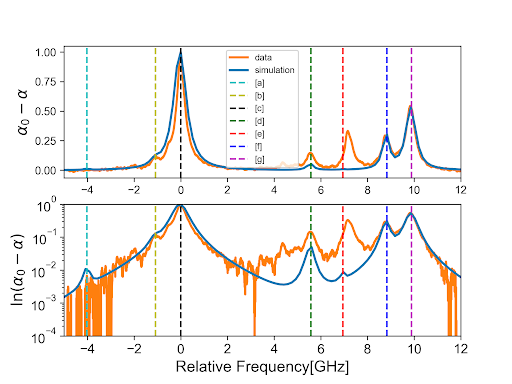April 01, 2025
Simulating Doppler-free Spectroscopy (DFSS) on LTX-beta: a Collaboration with PPPL
SOKENDAI Student Dispatch Program program year: 2024
Joseph John Simons

Comparison between Experiment (orange) and simulation (blue) of DFSS on low-temperature plasma. Each of the peaks in the graph are called Lamb peaks, and are what I am researching. Each peak corresponds to a specific electron transition, represented by the dotted vertical lines.
Recent work has shown that the shape of Lamb dips that result from Doppler Free Spectroscopy (DFSS) is dependent on plasma discharge conditions. If we can properly model this relationship, then we can possibly use DFSS as a fusion diagnostic! This is significant as DFSS may be better equipped than current fusion diagnostics at measuring certain parameters like electron density at the plasma edge region. The LTX-beta machine at the Princeton Plasma Physics Laboratory (PPPL) recently built a DFSS system and, having seen my previous work, they asked me to tailor my DFSS model to LTX-beta to predict plasma behavior in the edge region, which is notoriously difficult to measure.
We initially believed it possible to include linear (and not quadratic) Stark broadening terms into the model in order to more accurately represent LTX-beta, but we were able to prove that it was impossible to separate out the two effects within LTX-beta, as it was the quadratic Stark effect that designated the linear Stark effect regions along our line of sight. As such, a more intensive framework of energy states and transitions is necessary. A future collaboration or postdoc opportunity at PPPL will see me continue this work.
Period of Stay
Date of Departure: 2025/1/12
Date of Return: 2025/2/10
Country and/or City
Princeton, USA
Visiting Institute, Host, or Meeting
Princeton Plasma Physics Laboratory
Title of your Presentation
Simulating Doppler-free Spectra using the Collisional Radiative Model:
Background in preparation for collaboration at PPPL
What you learned and achieved during the visit
I met who I believe is the only other theorist in the world working on the same issue, and they taught me a great deal about our studies. When I proved that our initial assumption did not work I was inspired at how quickly we were able to pivot to new ideas.
Additionally, I was able to network with many wonderful scientists who inspired me greatly. It was humbling to meet people who were already fans of my work and excited to see my career unfold.
Department of Fusion Science, Joseph John Simons
